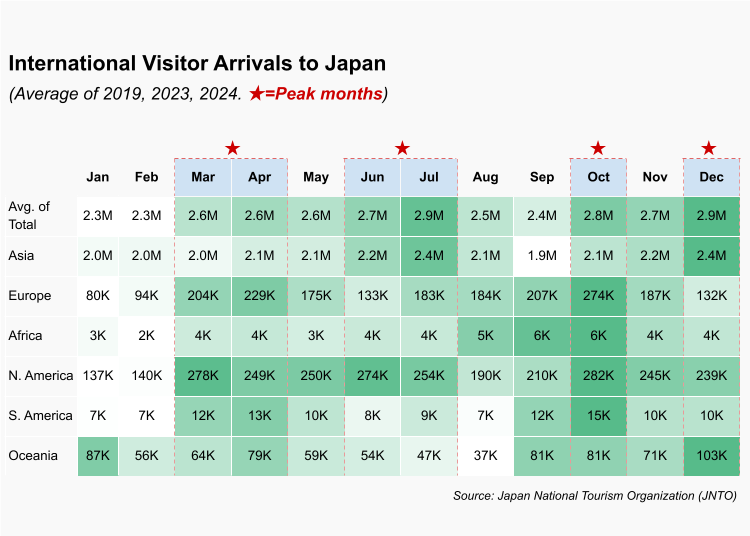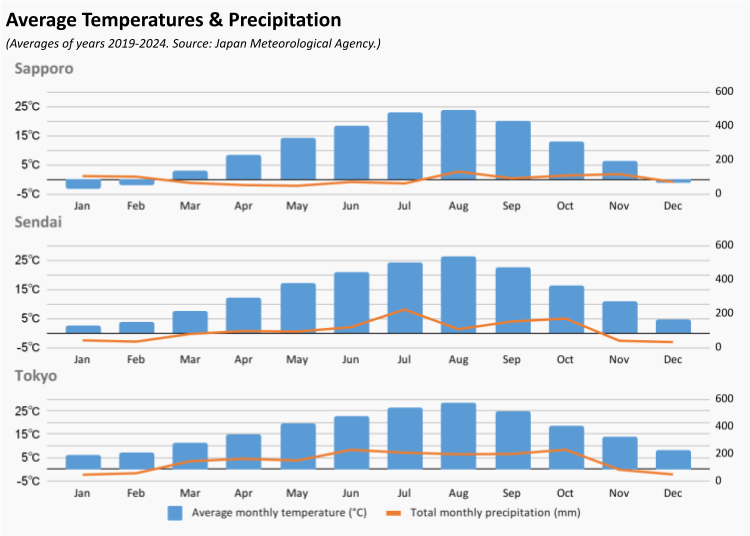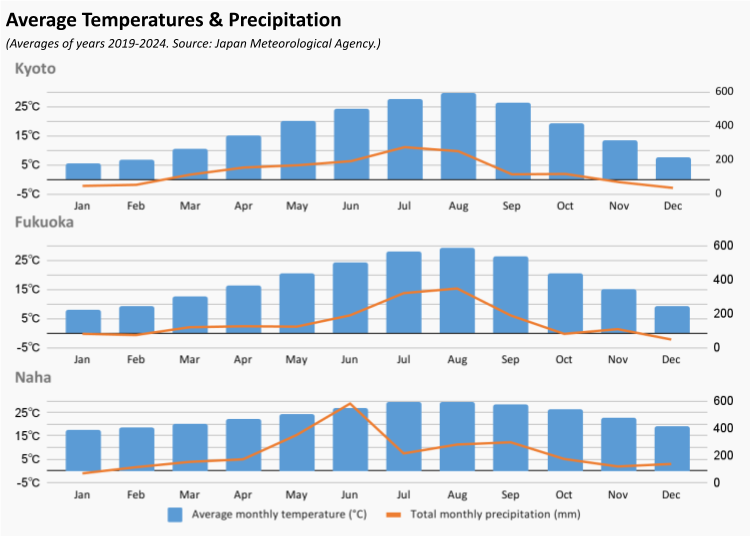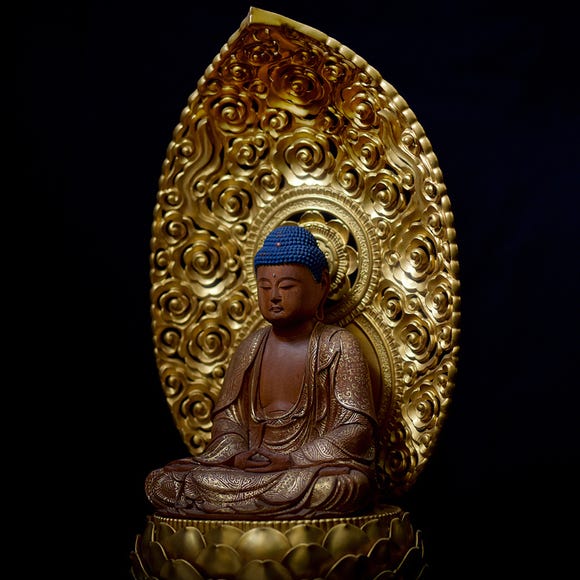
Planning Your Japan Trip in 2025-2026: Best Times to Visit & Seasonal Tips
- Written by: LIVE JAPAN's editorial team
When's the best time to visit Japan? The answer isn't one-size-fits-all! Whether you're dreaming of cherry blossoms, vibrant festivals, snowy slopes, or serene temples, Japan offers a unique experience every season. Careful attention needs to be paid to when, not just where, when planning your unforgettable adventure.
To help you pick the perfect time and get the Japan you've dreamed of, we've created the ultimate guide to Japan’s seasons, weather, and crowd trends.
(This article may contain promotions)
- Table of Contents
-
- When to Visit Japan: It All Depends on You!
- Quick Guide: Best Times to Visit Japan
- Navigating Crowds & Costs in 2025
- Japan's Seasons: Pros, Cons & What to Expect
- Visiting Japan in Spring
- Visiting Japan in Summer
- Visiting Japan in Autumn
- Visiting Japan in Winter
- List of Annual Events and Japan National Holidays 2025
- What to pack for Japan
- Final Word
When to Visit Japan: It All Depends on You!
Japan is beautiful 365 days a year, but what you see can vary dramatically by season. That's why it's essential to create a list of goals for your trip first. Do you want to:
See cherry blossoms or autumn leaves?
Avoid crowds and save money?
Hit the ski slopes?
Experience festivals in summer or beach weather?
Visit the Osaka Expo?
Once you know your priorities, use this guide to find the season that suits your needs best!
Quick Guide: Best Times to Visit Japan

Generally, the periods between March to May (Spring) and September to November (Autumn) offer the best weather.
・Optimal Balance: May and October-November are often ideal for balancing pleasant weather, fewer crowds, and lower prices (outside of specific holidays).
・Nature Lovers: Spring for cherry blossoms and late autumn for stunning foliage.
・Winter Travel: December-February can be great for fewer tourists (outside of snow resort areas like Niseko in Hokkaido and New Year countdowns) and lower prices, though it's colder.
Even during peak seasons, visiting Japan can still be very enjoyable: just consider exploring less-touristed yet beautiful regions like Tohoku, Shikoku, or Kyushu for a more relaxed experience.
Navigating Crowds & Costs in 2025
Understanding peak times is crucial for your budget and sanity.
When is the least crowded time to visit Japan?

If you're looking to visit Japan when it's less crowded with international tourists, January, February, and September are your best bets. Here’s why:
・January & February: Despite being winter, they see the lowest total international arrivals, especially from regions like Europe, Oceania, and South America. This is an excellent time to enjoy winter festivals, onsen towns, and ski resorts, generally with fewer crowds elsewhere.
・September: While still warm and potentially affected by typhoons, it has lower visitation than the summer peak (July–August) and sees a dip in arrivals from Asia and North America. If you aim for early or late September, you can often catch the tail end of summer without the crowds.
- March: Very busy due to the good weather and cherry blossoms.
- Late April to Early May: The week-long holiday of Golden Week occurs.
- Mid-August: The most popular time for Japanese to travel due to the Obon holiday period.
- Late December to Early January: The New Year period is when many Japanese travel to their hometowns or go on vacation.
- Trains, flights, and hotels are often nearly fully booked, and you can also expect traffic jams and packed train stations during these periods.
When is the cheapest time to visit Japan?

Airfares to Japan often decrease from September as tourist numbers dwindle and flight prices adjust. Depending on your travel dates, you could find flights for less than US$1,000!
For accommodation, winter, excluding ski resorts, is typically the least expensive period. Many hotels offer off-peak specials, including weekday discounts. However, note that hotel rates often increase during public holidays, so check the calendar to prevent unexpected costs.
Japan's Seasons: Pros, Cons & What to Expect


Japan has four distinct seasons, each offering unique experiences. To make the most of your trip, start by considering what you want to do, then select the season that best suits your interests.
For instance, if you're into hiking, the cooler weather of spring or autumn is ideal.
Prefer beaches? Aim for late June or August.
Dreaming of a ski holiday? January through March is your window.
Plan your activities first, then use this seasonal guide to help you decide when to go. We've outlined the key pros and cons of each season to make it easy to find the best time for your trip.
Visiting Japan in Spring

Spring (March – May) in Japan is defined by crisp, clear days and bursts of color from blooming flowers. Warm afternoons and cool nights make it ideal for sightseeing, with Tokyo averaging 19°C (66°F) in April and cooler temperatures in Sapporo around 11°C (53°F).
This is peak tourist season, with cherry blossoms drawing massive crowds from late March to mid-April. Hotspots like Kyoto, <@Nara|a=article:a2000489>, <@Tokyo|a=article:a0000001@>, and Hirosaki are especially popular and require hotel bookings up to 6–8 months in advance.
Golden Week (April 29 – May 6) further drives up travel demand, with surging hotel prices and packed trains and highways nationwide. Families often vacation during this period, intensifying congestion across major cities and tourist routes.
On the plus side, spring is breathtaking: cherry blossoms aside, wisteria tunnels in Ashikaga, tulip fields in Tonami, and flower parks in Hitachi add layers of seasonal charm. Just beware of crowds, lingering chill in northern areas, and pollen allergies if you're sensitive.
- In terms of clothes, bring both light clothes, along with a few jackets, sweaters and pants.
- Be prepared for crowds, even before peak cherry blossom bloom, and try to get most of your sightseeing finished before rush hour, starting at around 6 PM.
- Hotels in Kyoto get booked out as far as 6-8 months ahead. Reserve your accommodations as early as possible to avoid disappointment.
- If you’re allergic to pollen, be sure to bring OTC medicine like Allegra or Zyrtec.

Bottom Line
In terms of weather, spring is one of the best times to visit Japan. However, choosing another season is recommended for those wanting to avoid crowds.
- General
- ・Japan Cherry Blossom Forecast
・Tokyo Sightseeing Done Right: What to Wear in Spring
・Visiting Hokkaido in Spring
- March
- ・Visiting Japan in March
・Best Things to Do in Tokyo in March
・What to Do in Osaka & Kyoto in March
Visiting Japan in Summer

Summer (June – August) in Japan swings from muggy rains to blazing sunshine. Expect high humidity during the rainy season (tsuyu) in June and early July, with Tokyo peaking at 31°C (88°F) in August, while Hokkaido stays relatively comfortable around 26°C (80°F).
Rainy season tends to quiet tourist crowds, but mid-August's Obon Week (around August 13–16) sees a sharp spike in domestic travel, filling up trains and accommodations much like Golden Week. If you're crowd-averse, it’s best to avoid this period.
Despite the heat, summer is packed with cultural highlights ranging from Kyoto's Gion Matsuri in July to the dazzling fireworks festivals in Tokyo, Osaka, to the Three Great Festivals of Tohoku. For those chasing sun and sand, beach destinations like Okinawa, Kamakura, Shirahama, and Amami shine in August.
On the downside, extreme humidity, buzzing insects, and potential typhoons (especially from late August onward) can be challenging. Mt. Fuji is also often hidden behind clouds until later in the season.
- You'll need plenty of light, breezy clothes to endure the heat.
- If you’re planning on mountain climbing or visiting Hokkaido, then pack some jackets and pants.
- The humidity will make you sweat a lot, so bringing or buying deodorant is also recommended.
- The summer sun is very glary, especially on concrete streets, so decent sunglasses are necessary.
- Buy a cheap plastic umbrella at a convenience store if you’re out on a rainy day.
- Lastly, be careful of crowds at events, especially fireworks shows. Some of the larger ones will overburden trains for hours, and you may get stuck somewhere.

Bottom Line
Despite its reputation, summer is a great season to spend in Japan. Through the huge array of local festivals, it is arguably when the roots of traditional Japan are felt most strongly. For those sensitive to humidity, perhaps wait for another time.
- General
- ・18 Things to Know About Visiting Japan in Summer
・Complete Guide to Surviving Japan's Rainy Season
・25 Beautiful Traditional Festivals in Japan
・7 Best Glamping Sites Near Mt. Fuji
・Visiting Osaka in Summer
- June
- ・Visiting Japan in June
・Best Things to Do in Tokyo in June
・What to Do in Osaka & Kyoto in June
Visiting Japan in Autumn

Autumn (September – November) brings welcome relief from the summer heat, though conditions vary—September can still feel warm and humid, while October ushers in crisp, comfortable days. Tokyo sees highs around 22°C (72°F) in October, while places like Sapporo and Sendai cool to lows around 7–11°C (45–52°F).
September is one of the quieter months for international travel, making it a great time to explore with fewer crowds—if you can dodge typhoons. By contrast, October and November see increasing visitors drawn by fall foliage.
November is peak season for autumn leaves in northern areas, like Hokkaido, Tohoku, and even Nikko. Meanwhile, early December tends to be peak foliage season for places like Tokyo, Kyoto, and Nara. Hotels in these areas often sell out weeks or even months in advance.
The rewards of autumn include striking colors, mellow weather, and a relaxed atmosphere, particularly in September. However, early typhoons and packed viewing spots in late autumn can complicate travel.
- To beat the crowds, avoid foliage hotspots on weekends and public holidays. Aim to visit mid-week instead.
- If a typhoon is predicted to hit your area, ensure you have accommodation and supplies for that period, and refrain from venturing outside. Keep an eye on the news for landslides or flood warnings, and ask your accommodation staff for information on evacuation points if the weather worsens significantly.

Bottom line
If you can successfully navigate around typhoons, you'll be rewarded with amazing scenery, fantastic weather, and quiet tourist attractions. Autumn is a strong contender for the best time to visit Japan.
- General
- ・Autumn Leaves & Fall Foliage Forecast
・Visiting Tokyo in Autumn: Travel & Weather Guide
・Visiting Osaka in Autumn: What to Wear & Must-Visit Attractions
- September
- ・Visiting Japan in September
・Best Things to Do in Tokyo in September
・What to Do in Osaka & Kyoto in September
Visiting Japan in Winter

Winter (December – February) in Japan is cold but often dry and sunny, especially in cities like Tokyo, where lows hover around 1°C (34°F). In contrast, ski areas such as Niseko, Hakuba, and Nozawa Onsen plunge well below freezing with reliable snowfall.
Early December is an underrated time to visit, with somewhat lighter crowds, crisp weather, and more affordable hotel rates. However, the year-end holiday period (around December 29 – January 5) brings a travel surge, packed trains, and many shop closures.
For winter highlights, look to Sapporo’s powdery slopes, snowy onsen towns like Ginzan Onsen and Nyuto Onsen, and dazzling illuminations in Kobe, Tokyo, and Nagoya. Views of Mt. Fuji are often clearest in winter, making it a great time for photography. Be sure to check out ski packages ahead of time as they can sell out quickly. And don't get us started about countdown parties in Tokyo and Osaka, or the fantastic New Year sales.
Downsides include biting cold, occasional travel disruptions from snow, and limited dining or shopping options during New Year closures. Still, outside the holiday rush, winter offers quiet beauty and unique seasonal charm.
- If you're planning on enjoying cities such as Tokyo, Osaka, Kyoto, or Hiroshima, simple winter clothing, such as sweaters, jackets, and scarves will suffice.
- However, if you're heading to ski resorts, mountains, or snowy regions, specialized snow boots, puffy jackets, raincoats, and other winter protections are a necessity to survive the harsh conditions.
- Train delays are common during heavy snowfall, along with heavy traffic on the road. Be prepared for your trip to be affected.
- Be wary of New Years, known as oshogatsu, which is a public holiday week. While it is common for most Japanese to stay home, shops, restaurants, ski resorts, and other attractions are usually busy, and some may decide to close. Be sure to double-check the places on your itinerary before you go!

Bottom line
While winter is not for everyone, most major cities enjoy mild and consistent weather. However, some prefectures are prone to harsh conditions, and care should be taken before traveling. Crowds will be thin and most attractions quiet outside New Years and public holidays. For skiers, there's no better time!
- General
- ・Complete Guide to Skiing in Japan
・Fun Things to Do in Winter in Japan
・What's Christmas Like in Japan?
・What to Do During New Year’s and New Year's Eve
・Visiting Hokkaido in Winter
- December
- ・Visiting Japan in December
・Best Things to Do in Tokyo in December
・What to Do in Osaka & Kyoto in December
List of Annual Events and Japan National Holidays 2025

Following are Japan's national holidays. Particularly around the row of holidays in May (known as Golden Week), you can expect sightseeing areas, attractions, and major cities to be more crowded.
If you plan on traveling around these dates, be sure to make hotel, train, and activity reservations in advance to avoid inconvenience. You may also wish to consider booking tables at popular restaurants as well.
- January 1 - New Year
- January 13 - Coming of Age Day
- February 11 - National Foundation Day
- February 23 - Emperor's Birthday (Obs. on February 24)
- March 20 - Spring Equinox
- April 29 - Showa Day
- May 3 - Constitution Memorial Day
- May 4 - Greenery Day (Obs. on May 6)
- May 5 - Children's Day
- June 21 - Marine Day
- August 11 - Mountain Day
- September 15 - Respect for the Aged Day
- September 23 - Autumn Equinox
- October 13 - Sports Day
- November 3 - Culture Day
- November 23 - Labor Thanksgiving Day (Obs. on November 24)
- February 14 - Valentine's Day: Not a national holiday but celebrated in Japan, women present chocolates to men, including male colleagues, on Valentine's Day.
- March 3 - Doll's Festival (Hina Matsuri): Families with girls observe this day for their happiness and success, displaying special hina dolls at home and participating in community events.
- March 14 - White Day: This day mirrors Valentine's Day, with men giving chocolates or sweets to women.
- July/August 7 - Star Festival (Tanabata): This festival period, rather than a national holiday, commemorates the meeting of deities Orihime and Hikoboshi. Notable celebrations occur in Hiratsuka in July and Sendai in August.
- Mid-August - Obon: From around August 13-15, this Buddhist event honors ancestral spirits and is a period for family reunions.
- November 15 - Seven-Five-Three Day (Shichi-Go-San): This day marks a traditional rite of passage where families visit shrines and temples to pray for their children's well-being and growth, according to customs established over 800 years ago.
- December 25 - Christmas: While not a national holiday in Japan, it brings festive decorations and intimate celebrations, often involving a chicken dinner with loved ones or seeing Christmas illuminations.
- December 31 - New Year's Eve (Omisoka): Despite not being a national holiday, many businesses close early in preparation for New Year celebrations.
What to pack for Japan
With Japan’s four distinct seasons and subtle climate changes, travelers often question what clothes to pack. But bringing extra clothes “just in case” can make for one crammed suitcase!
Try ‘Any Wear, Anywhere’ to reduce your suitcase space

‘Any Wear, Anywhere’ lets you rent stylish clothes in Japan for any season and most sizes, helping you pack lighter and travel greener. By using surplus and secondhand garments, it reduces both luggage weight and carbon emissions—so you can explore Japan with a lighter load and a clear conscience.

Using ‘Any Wear, Anywhere’ is easy. Simply access the official website from your PC or smartphone and reserve your wardrobe before traveling to Japan.

When you arrive in Japan, simply pick up your stylish rental clothes at your hotel. After use, return the clothes to your hotel without the need for cleaning.

Clothing sizes range from XS to 3XL, and kids 80 to 160. Clients can choose from a combination of styles (for men, women or kids), season (spring/autumn, summer or winter).
Take a look at these examples of seasonal garments for rent
Next, let’s look at some of the menswear and womenswear rental clothes in three different seasonal styles: spring/autumn, summer, and winter!

First up: clothing for spring and autumn. These seasons in Japan are generally mild, with daytime highs around 20°C (68°F), but temperatures can dip in the evenings—and occasional warm or chilly days can catch you off guard.
With ‘Any Wear, Anywhere,’ you’ll have access to shirts and T-shirts that are perfect for layering, making it easy to adjust to the day’s changing conditions.

Summer in Japan is hot, humid, and sunny. With ‘Any Wear, Anywhere,’ you’ll get light, breathable items like T-shirts and sleeveless tops to help you stay cool while sightseeing.
Since heavy rain and typhoons are common from July to September, short-length pants are also included to keep you more comfortable during sudden downpours.

Warm clothing is a must for winter in Japan, where temperatures often drop below freezing. With ‘Any Wear, Anywhere,’ you can rent down jackets and other outerwear to stay protected from the cold—without stuffing your suitcase.
To layer up, choose from popular rental items like sweaters and long-sleeved tops that help keep you warm under your jacket.
(*All accessories are the stylist’s own.)
Final Word
No matter when you visit Japan, you'll have a good time! Japan is a country that celebrates each season accordingly, making for year-round fun! However, if you have a specific activity or interest, choosing the best time to visit Japan for you is extremely important.
Balancing this with crowds and costs will also help you get the most out of your Japan trip. By reading this guide, you'll have all the information you need to enjoy Japan's wonders to their fullest extent!
(This article was last updated in June 2025.)
LIVE JAPAN's editorial team is a multicultural mix of native editors who have lived in Japan for over five years, alongside Japanese editors with a deep passion for travel. We're devoted to sharing the wonders of Japan. From cultural insights and history to events, practical travel tips and coupons, we're here to help make your journey unforgettable!
- Category
*Prices and options mentioned are subject to change.
*Unless stated otherwise, all prices include tax.
Recommended places for you
-

Jukuseiniku-to Namamottsuarera Nikubaru Italian Nikutaria Sannomiya
Izakaya
Kobe, Sannomiya, Kitano
-

ANO-NE Kids Club
Other Sightseeing
Ginza
-
Goods

Yoshida Gennojo-Roho Kyoto Buddhist Altars
Gift Shops
Nijo Castle, Kyoto Imperial Palace
-

Osaka JOINER
Other Sightseeing
Namba, Dotonbori, Shinsaibashi
-
Events

Sunflower terminal (Osaka) Terminal 1
Other Sightseeing
USJ, Nanko Port
-
Appealing

Rukku and Uohei
Izakaya
Sapporo / Chitose
-
Ad

Tokyo Comedy Bar: Where Jokes and Craft Beer Flow Freely
-

A Don Quijote Like No Other: Step Inside the All-New Tourist-Friendly Store at Shinjuku Tonanguchi Bekkan (Open June 13)
by: Chehui Peh
-

Japan Summer Sales 2025: Your Ultimate Guide to Shopping Deals In Tokyo, Kansai & More!
-

Discover Japan Duty Free GINZA: A Unique Shopping Experience in the Heart of Tokyo
by: Chehui Peh
-
Ad

Lapoppo Farm, one of Japan's leading makers of sweet potato treats! An in-depth guide to the secrets behind its popularity, including best-selling products and facilities!
-

Step Into the World of Chiikawa: Immersive 'Chiikawa Park' to Open in Ikebukuro's Sunshine City This July!
-
Ad

Explore Shinjuku: The Coolest Neighborhood Where Old Tokyo Meets Modern Tokyo!
-

Japanese Foods List: 16 Crazy Tasty Japanese Tohoku Region Dishes You've Never Heard of
-

Kichijoji – Explore Tokyo’s Top-Rated Stylish Suburb in Half a Day!
-

Say 'Kampai' with a Sake Tour at Hachinohe Brewery
by: Chehui Peh
-

Guide to Tokyo's Old Quarter: 7 Quaint Spots in Yanesen!
-

Looking for a Different Kind of Animal Café in Tokyo? Try Hedgehogs!
- #best sushi japan
- #what to do in odaiba
- #what to bring to japan
- #new years in tokyo
- #best ramen japan
- #what to buy in ameyoko
- #japanese nail trends
- #things to do japan
- #onsen tattoo friendly tokyo
- #daiso
- #best coffee japan
- #best japanese soft drinks
- #best yakiniku japan
- #japanese fashion culture
- #japanese convenience store snacks
























